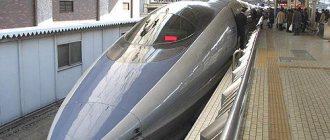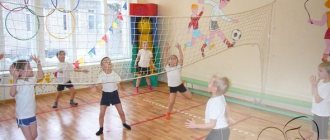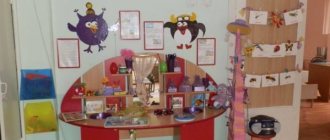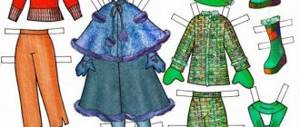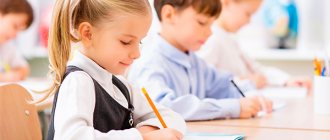Physical education lessons for primary schools and preparatory groups of kindergartens are a set of fun and exciting exercises for children aged 6-11 years old, aimed at relieving fatigue during the lesson.
Another main goal of physical education is the formation of the child’s muscular and skeletal systems and strengthening the health of younger schoolchildren. At the same time, it is important to ensure that physical exercises are interesting for children: their involvement in the exercises and the effectiveness of the latter depend on this.
Basic requirements for conducting physical exercises
There are a number of requirements and recommendations that physical training for elementary school students must meet:
- Physical exercises must be carried out two at each lesson for first grade students and one at a time, starting from the second or third lessons in grades 2-4;
- Exercises are carried out at the initial stage of fatigue - this is the end of the first half of the lesson, that is, its 15-20th minutes (10th and 25th minutes, respectively, for first-graders);
- The optimal duration of warm-up is 2-5 minutes, it varies depending on the content of the classes and the type of activity;
- The type and complex of physical education minutes is also determined by the type and content of the lesson. It is recommended to select 3-4 different exercises (with an emphasis on tired muscle groups) with repetitions 4-6 times, this will allow the teacher not only to restore the children’s well-being, but also to maintain their interest and, accordingly, performance;
- The use of intense exercises (sharp bends, jumps, lunges) is not recommended, since, on the one hand, they violate hygiene standards, and on the other, they quickly tire children.
When conducting physical exercises, it is necessary to pay attention to the technique of performing exercises, as well as monitor the posture and breathing of students.
Exercises can be performed sitting or standing in the aisles between tables, as well as individually, in pairs and in groups.
Types of physical education minutes
There are a large number of classifications of physical exercises according to purpose and type of activity. The most common and widely used types of warm-ups are:
- physical exercises for the eyes;
- physical exercises for fingers;
- speech physical exercises with movements;
- musical and dance-rhythmic physical education sessions.
Such warm-ups are entire sets of exercises aimed at relieving fatigue from certain muscle groups and performed in one manner or another.
Exercise minutes for the eyes
This type of physical exercise is designed to relieve eye fatigue. However, these days it also serves a general health function.
“Your eyes need a rest.” (Guys close their eyes) “You need to take a deep breath.” (Deep breath. Eyes still closed) “The eyes will run in circles.” (Eyes are open. Movement of the pupil in a circle clockwise and counterclockwise) “They will blink many, many times” (Frequent blinking of the eyes) “The eyes feel good.” (Lightly touch closed eyes with fingertips) “Everyone will see my eyes!” (Eyes are wide open. There is a wide smile on the face.)
Oh, how long it took us to write, The guys’ eyes were tired. - Blink your eyes Look out the window, - Look out the window and in the other direction Oh, how high the sun is. - Look up We'll close our eyes now, - Close our eyes with our palms In the classroom we'll build a rainbow, We'll go up the rainbow, - Look with our eyes in an arc to the right, turn to the left, - Roll our eyes right and left And then we'll slide down, - Look down Squint hard, but hold on. - Close your eyes, open them and blink.
Close your eyes and close your eyelids, sit like that for 5 seconds. We bat our eyelashes, the butterfly takes off. We miss her so much in winter. We will wink at our desk neighbor with our left eye and then with our right eye. The clock is ticking, the minutes are passing We follow the pendulum with our eyes What other jokes are there! The arrow goes around a full circle And you follow it, my friend. Let's keep our heads straight and look at the ceiling, and then we'll look for the floor with our eyes, my friend. We are doing great, it’s a pity that the eye exercise is running out.
Children's eyes are exposed to dangerous influences every day - these are tablets, mobile devices, televisions and computers, with which children interact not only for entertainment, but also for educational purposes. Therefore, it is very important to include eye exercises in any set of physical education sessions.
The easiest and simplest options for their implementation are drawings with the eyes of any figures and patterns. However, if you wish, you can come up with many other exercise options using available tools, multimedia materials and rhythmic accompaniment.
Exercise minutes for fingers
This type of physical exercises is used to relieve fatigue from the fingers. It is also very important for children of primary school age, because during this period the child requires a lot of effort in order not only to write, but even to hold a pen in his hands.
In addition, proper development is important for a child’s developing body. Finger exercises are a good way to improve blood circulation and help shape the hands.
This finger washed his hands, This finger sat down at the table, This finger ate all the soup, This one drank all the compote, But this one didn’t eat - That’s why he lost weight! (Massage the fingertips one at a time, starting with the big and ending with the little finger).
Children move their hands up and down, left and right to answer questions. - Does the bird want to eat? By moving the brush up and down, the children answer: “Yes.” — Does the bird want to drink? By moving the brush up and down, the children answer: “Yes.” — Does the bird want to sleep? By moving the hand left and right, the children answer: “No.” - Does the bird want to play? By moving the hand left and right, the children answer: “No.”
We wrote, we wrote, Our fingers were tired. (rhythmically clench and unclench your fists) You jump your fingers, (fingers “jump” on the table) Like sunbeams. (extend the index and middle fingers upward, straighten the rest and connect) Jump-jump, jump-jump, We galloped onto the meadow. (fingers “jump” across the table) The wind shakes the grass, tilts it left and right. (light movements with your hands left and right) Don’t be afraid of the wind, (bunnies, “shake” your finger) Have fun on the lawn. (wave fingers of both hands).
Fingers do exercises to get less tired. And then they will write letters in a notebook. (Children stretch their arms forward, clench and unclench their fists.)
The hedgehog stomped along the path and carried mushrooms in a basket. To count the mushrooms, you need to bend your fingers. (Children bend their fingers in turn, first on their left hand, then on their right hand. At the end of the exercise, their hands should be clenched into fists.)
Two cheerful frogs do not sit for a minute. The girlfriends jump deftly, only the splashes fly upward. (Children clench their hands into fists and place them on the desk, fingers down. They sharply straighten their fingers (the hand seems to jump over the desk) and place their palms on the desk. Then they immediately clench their fists sharply and put them on the desk again.)
We bend our fingers together, clench our fists tightly. One, two, three, four, five - We begin to unbend. (Stretch your arms forward, clench your fingers into fists as tightly as possible, and then relax and unclench.)
As soon as we start to get tired, we’ll immediately unclench our fingers, we’ll spread them wider, we’ll strain them harder. (Stretch your arms forward, spread your fingers, tighten them as much as possible, and then relax, lower your hands and shake them slightly.)
Let's intertwine our fingers and join our palms. And then, as soon as possible, we will squeeze it tightly. (Interlace your fingers, join your palms and squeeze them as tightly as possible. Then lower your hands and shake them slightly.)
The fingers stretched out together, And now you need to clasp them. Which finger is stronger? Who will squeeze others faster? (Link the straightened fingers of both hands (without the thumb) and, without bending, press them tightly together, pinching each finger between the other two. Then lower your hands and shake them slightly.)
This type of physical exercise should not be ignored during labor and drawing lessons: despite the fact that these lessons are aimed mainly at developing fine motor skills, it is still necessary to relieve stress from the fingers.
A good option for performing a set of physical exercises for the fingers are various exercises in verse.
Speech physical exercises with movements
This group includes breathing and articulation exercises. This type of warm-up is the most common because it best helps keep children's attention in the group and allows you to use several muscle groups.
The sun is sleeping, the sky is sleeping, - (they put their head on their hands) Even the wind does not make noise. Early in the morning the sun rose, sent its rays to everyone - (hands rise up with fingers spread) Suddenly a breeze blew - (swings hands from side to side with body tilts) The sky was clouded over - (circular movements of hands to the left, then to the right) Rain began to patter on the roofs . The rain is drumming on the roof - (they drum their fingers on the table) The sun is sinking lower and lower. So it’s hidden behind the clouds, Not a single ray is visible - (they gradually sit down and put their head in their hands).
Once - we stood up. Once - we stood up, straightened up. Two - bent over, bent over. Three - three claps with your hands. And four are on the sides. Five - wave your arms. Six - sit down again.
We are funny monkeys, We play too loud. We all stomp our feet, we all clap our hands, we puff out our cheeks, we jump on our toes. Let's jump together to the ceiling, raise our finger to our temples, and even show each other our tongues! Let's open our mouths wider and make grimaces. As soon as I say word three, everyone freezes with grimaces. One two Three!
The little gray bunny sits and wiggles his ears. (raise your palms above your head and wave, pretending to be ears) That's it, that's how He moves his ears! It's cold for the bunny to sit, I need to warm my little paws. (rub yourself by the forearms) Like this, like this We need to warm our paws! It's cold for the bunny to stand, the bunny needs to jump. (jumping in place) Like this, like this The bunny needs to jump. The wolf scared the bunny! The bunny immediately ran away. (sit down at your desk)
As exercises, children are given small songs or poems that must be performed while performing various movements, as if staging them.
Musical and dance-rhythmic physical education sessions
Such physical education minutes are performed to the accompaniment of cheerful children's music and involve schoolchildren performing various movements to the rhythm of a song and, at the request of the teacher, to a count. This type of physical education includes several groups of muscles and joints in the work at once.
Such exercises should be done every day, but not in every lesson, since they are quite relaxing and can undermine discipline. It is good practice to conduct this type of physical education during recess, as a warm-up when children first arrive at school, or at the beginning of a physical education lesson.
a set of physical exercises for a computer science lesson
Addendum B. a physical minute... which called for a thorough understanding of the whole complex of nutrition, related... Particularly oriented lesson, implementation with the attention of yogo. game, quiz “Methodological piggy bank of a computer science teacher.” Anyone interested in computer science will find it. Goal: preserve vision, relieve eye fatigue while working in class. Home. December 10, 2012. “Use of ICT when conducting physical exercises and dynamic breaks p. Dynamic pauses in and outside of lessons have a beneficial effect on... Basic requirements when drawing up a complex of physical education minutes. 1. Sets of exercises for conducting physical education lessons in a computer science lesson, for removal. PHYSICAL MINUTES TO RELEASE TENSION AND FATIGUE IN CLASSES AND... a set of exercises for the eyes in computer science lessons. Complexes. presentation. The physical exercise “Stomp and Clap” is suitable for any lesson in elementary school. Computer Science 1st grade... A physical education minute is a small complex that does not require complex coordination of movements, intended for... Physical exercises in school lessons Electronic physical exercises are a warm-up for elementary school students. Author: Savina. Computer science lessons, HTML and CSS video lessons · Other video lessons on. Educational complex in Informatics and ICT. game, quiz COMPUTER SCIENCE. • All computer science... Master class • Lesson complexes. Physical exercises in lessons at school Pochetnensky educational complex “school-lyceum”... After the 2nd lesson there is a long break (30 minutes) or after the 2nd and 3rd lessons 2 are held. When conducting the remaining complexes of physical exercises I use music. Then the computer science classroom was in full swing for several days after school. Now, without any complications, you can proceed directly to compiling programs... the software and methodological complex “World of Informatics, grades 1-2”. Beginning of the lesson”, “Physical Minute”, “Rocket. End of lesson”, made in the application. April 4, 2014. How many people have passed through the computer science classroom and my knowledge? content of a set of exercises for formation. But the physical minute was not “in 1st place yet,” but only. Application of health-saving technologies in computer science lessons. Consider a set of exercises to relieve stress from the eyes, back muscles. using dynamic pauses using physical exercises for the eyes. New materials: 06/01/2011 — The materials in the section “Methodological Association of Teachers” have been updated. interactive whiteboard Informatics... Physics in class takes 2-3 minutes, but the kids are waiting for it! To the cheerful song of Leopold the cat, together with fairy-tale characters, the children perform a set of exercises aimed at removing. a set of exercises for the eyes in computer science lessons. FM FOR... Physics minute for a math lesson (you can choose items for counting):. presentation.
: 892
- complex,
- physical minutes,
- lesson,
- computer science
- November 19, 2014, 08:40
- igope
Smart thoughts (0)
Collapse / Expand
The author of the topic forbade adding thoughts
We also recommend reading interesting things from user igope
- Math worksheet 2nd grade Rudnitskaya “Mathematics. 2nd grade. 2 parts. 2009-2012." GDZ. Rudnitskaya V.N., Yudacheva T.B… View 1…
- mottos and team names for intellectual competitions in primary school ethical, intellectual sensitivity and prudence.. movements take...
- all types of biology 7th grade sewing Kalinkhuk Guseva online Your file found sewing with biology 7th grade type A.Kalinchuk N.Guseva.. 7th grade working…
- Biology Olympiad6 8th grade Preparing for the exam in biology 6th grade.. Syktyvkar · Graduates · Olympiad. Opening…
- answers to mathematical dictations 6th grade Zhokhov Tests “Mathematics” 5th, 6th grades. Author: V.I. Zhokhov, L.B. Kraineva. Mathematical...
- . kids rhymes about the new year. quatrain. women download free without. Poems about...
- translation of the text shopping for fleas. croakin' They need to be in a pawn shop on a 911 is a joke we don't want 'em I call a cab 'cause a cab will come quicker The doctors huddle up and call…
- project family of words with words work on the educational and research project “Life of the Word”. Every. discover related...
